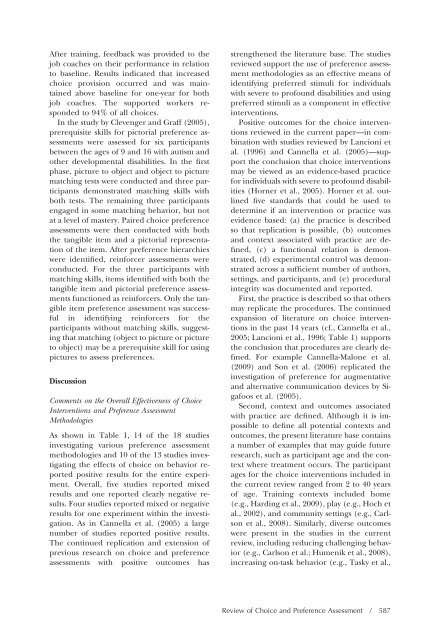etadd_46(4) - Division on Autism and Developmental Disabilities
etadd_46(4) - Division on Autism and Developmental Disabilities
etadd_46(4) - Division on Autism and Developmental Disabilities
Create successful ePaper yourself
Turn your PDF publications into a flip-book with our unique Google optimized e-Paper software.
After training, feedback was provided to the<br />
job coaches <strong>on</strong> their performance in relati<strong>on</strong><br />
to baseline. Results indicated that increased<br />
choice provisi<strong>on</strong> occurred <strong>and</strong> was maintained<br />
above baseline for <strong>on</strong>e-year for both<br />
job coaches. The supported workers resp<strong>on</strong>ded<br />
to 94% of all choices.<br />
In the study by Clevenger <strong>and</strong> Graff (2005),<br />
prerequisite skills for pictorial preference assessments<br />
were assessed for six participants<br />
between the ages of 9 <strong>and</strong> 16 with autism <strong>and</strong><br />
other developmental disabilities. In the first<br />
phase, picture to object <strong>and</strong> object to picture<br />
matching tests were c<strong>on</strong>ducted <strong>and</strong> three participants<br />
dem<strong>on</strong>strated matching skills with<br />
both tests. The remaining three participants<br />
engaged in some matching behavior, but not<br />
at a level of mastery. Paired choice preference<br />
assessments were then c<strong>on</strong>ducted with both<br />
the tangible item <strong>and</strong> a pictorial representati<strong>on</strong><br />
of the item. After preference hierarchies<br />
were identified, reinforcer assessments were<br />
c<strong>on</strong>ducted. For the three participants with<br />
matching skills, items identified with both the<br />
tangible item <strong>and</strong> pictorial preference assessments<br />
functi<strong>on</strong>ed as reinforcers. Only the tangible<br />
item preference assessment was successful<br />
in identifying reinforcers for the<br />
participants without matching skills, suggesting<br />
that matching (object to picture or picture<br />
to object) may be a prerequisite skill for using<br />
pictures to assess preferences.<br />
Discussi<strong>on</strong><br />
Comments <strong>on</strong> the Overall Effectiveness of Choice<br />
Interventi<strong>on</strong>s <strong>and</strong> Preference Assessment<br />
Methodologies<br />
As shown in Table 1, 14 of the 18 studies<br />
investigating various preference assessment<br />
methodologies <strong>and</strong> 10 of the 13 studies investigating<br />
the effects of choice <strong>on</strong> behavior reported<br />
positive results for the entire experiment.<br />
Overall, five studies reported mixed<br />
results <strong>and</strong> <strong>on</strong>e reported clearly negative results.<br />
Four studies reported mixed or negative<br />
results for <strong>on</strong>e experiment within the investigati<strong>on</strong>.<br />
As in Cannella et al. (2005) a large<br />
number of studies reported positive results.<br />
The c<strong>on</strong>tinued replicati<strong>on</strong> <strong>and</strong> extensi<strong>on</strong> of<br />
previous research <strong>on</strong> choice <strong>and</strong> preference<br />
assessments with positive outcomes has<br />
strengthened the literature base. The studies<br />
reviewed support the use of preference assessment<br />
methodologies as an effective means of<br />
identifying preferred stimuli for individuals<br />
with severe to profound disabilities <strong>and</strong> using<br />
preferred stimuli as a comp<strong>on</strong>ent in effective<br />
interventi<strong>on</strong>s.<br />
Positive outcomes for the choice interventi<strong>on</strong>s<br />
reviewed in the current paper—in combinati<strong>on</strong><br />
with studies reviewed by Lanci<strong>on</strong>i et<br />
al. (1996) <strong>and</strong> Cannella et al. (2005)—support<br />
the c<strong>on</strong>clusi<strong>on</strong> that choice interventi<strong>on</strong>s<br />
may be viewed as an evidence-based practice<br />
for individuals with severe to profound disabilities<br />
(Horner et al., 2005). Horner et al. outlined<br />
five st<strong>and</strong>ards that could be used to<br />
determine if an interventi<strong>on</strong> or practice was<br />
evidence based: (a) the practice is described<br />
so that replicati<strong>on</strong> is possible, (b) outcomes<br />
<strong>and</strong> c<strong>on</strong>text associated with practice are defined,<br />
(c) a functi<strong>on</strong>al relati<strong>on</strong> is dem<strong>on</strong>strated,<br />
(d) experimental c<strong>on</strong>trol was dem<strong>on</strong>strated<br />
across a sufficient number of authors,<br />
settings, <strong>and</strong> participants, <strong>and</strong> (e) procedural<br />
integrity was documented <strong>and</strong> reported.<br />
First, the practice is described so that others<br />
may replicate the procedures. The c<strong>on</strong>tinued<br />
expansi<strong>on</strong> of literature <strong>on</strong> choice interventi<strong>on</strong>s<br />
in the past 14 years (cf., Cannella et al.,<br />
2005; Lanci<strong>on</strong>i et al., 1996; Table 1) supports<br />
the c<strong>on</strong>clusi<strong>on</strong> that procedures are clearly defined.<br />
For example Cannella-Mal<strong>on</strong>e et al.<br />
(2009) <strong>and</strong> S<strong>on</strong> et al. (2006) replicated the<br />
investigati<strong>on</strong> of preference for augmentative<br />
<strong>and</strong> alternative communicati<strong>on</strong> devices by Sigafoos<br />
et al. (2005).<br />
Sec<strong>on</strong>d, c<strong>on</strong>text <strong>and</strong> outcomes associated<br />
with practice are defined. Although it is impossible<br />
to define all potential c<strong>on</strong>texts <strong>and</strong><br />
outcomes, the present literature base c<strong>on</strong>tains<br />
a number of examples that may guide future<br />
research, such as participant age <strong>and</strong> the c<strong>on</strong>text<br />
where treatment occurs. The participant<br />
ages for the choice interventi<strong>on</strong>s included in<br />
the current review ranged from 2 to 40 years<br />
of age. Training c<strong>on</strong>texts included home<br />
(e.g., Harding et al., 2009), play (e.g., Hoch et<br />
al., 2002), <strong>and</strong> community settings (e.g., Carls<strong>on</strong><br />
et al., 2008). Similarly, diverse outcomes<br />
were present in the studies in the current<br />
review, including reducing challenging behavior<br />
(e.g., Carls<strong>on</strong> et al.; Humenik et al., 2008),<br />
increasing <strong>on</strong>-task behavior (e.g., Tasky et al.,<br />
Review of Choice <strong>and</strong> Preference Assessment / 587
















